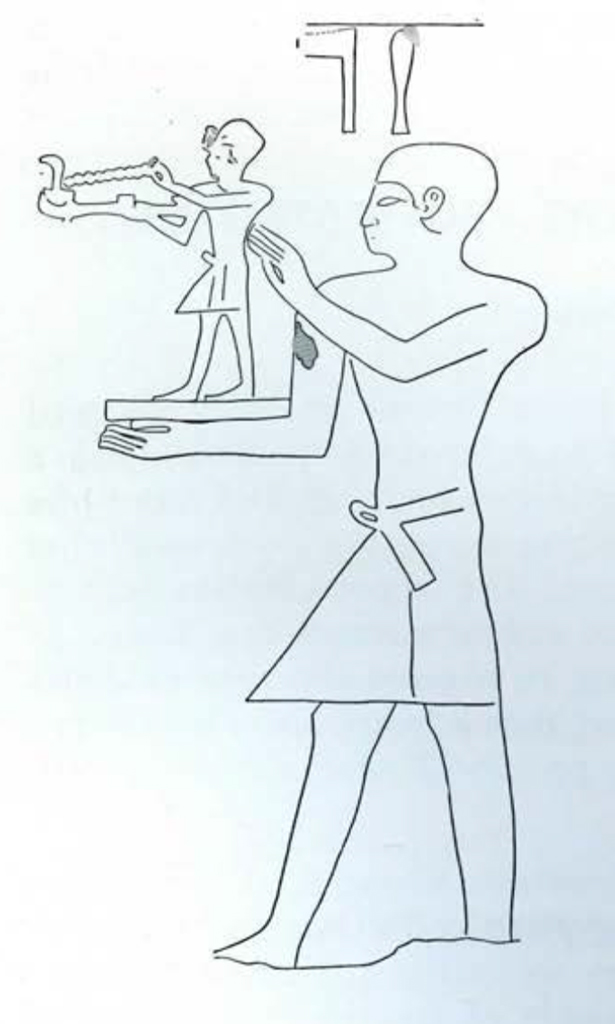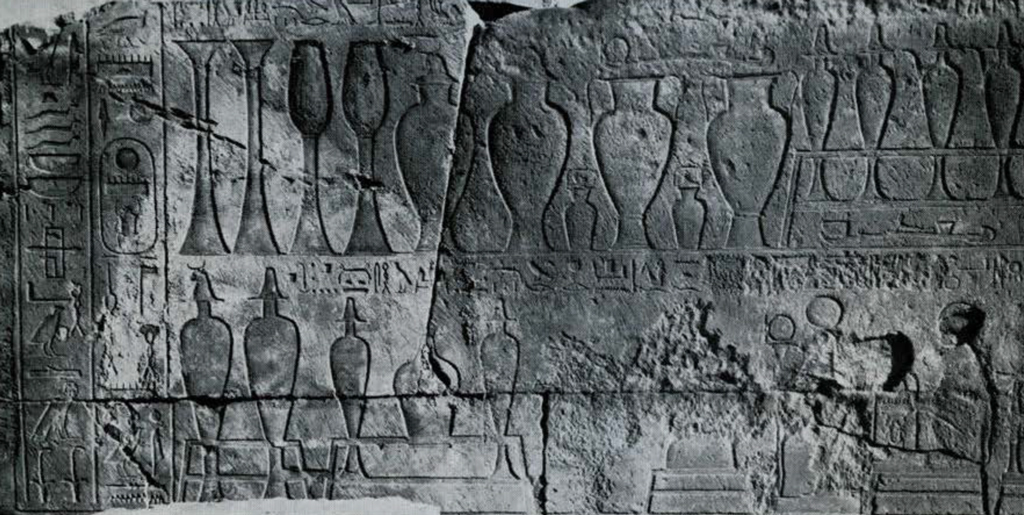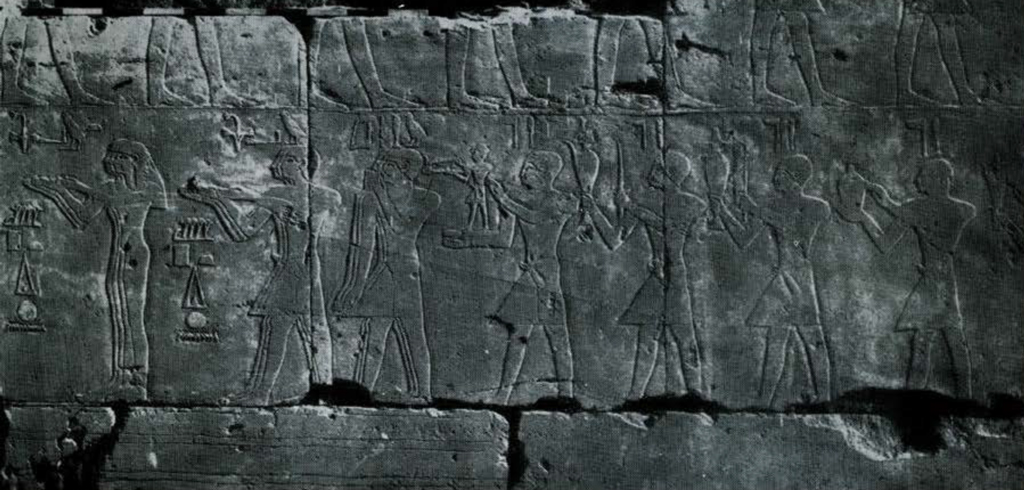It not infrequently happens that a dossier on some class of ancient objects is no sooner closed and the result published when a new, quite unsuspected piece of evidence turns up and has to be left outside the gate. Even in collecting the scanty evidence for so rare and striking a phenomenon as the representation of an Egyptian king on his belly, the same embarrassment can occur. In this case the awkwardness of having to present the new evidence in a postscript is mitigated by the fact that it bears out a hypothesis advanced in the article in question, pp. 26-42 of the March 1956 Bulletin.

That article described a small prostrate statuette of Amenophis III in the University Museum’s Egyptian collection and a similar statuette in Cairo which dates from an earlier period, a Sesostris of the Middle Kingdom, the first made of steatite, the second of bronze, As far as it went, the explanation given for the purpose of these statuettes may be summed up as follows.
An Egyptian king would have prostrated himself before none but a god. The statuettes therefore imply the god’s presence; that is, they probably belong to objects used in the rituals of a temple. The ritual object to which one of these statuettes – the bronze one – belonged can be inferred from the fact that it is affixed to the lid of a box; the contemporary type of arm-shaped censer has a lidded box of comparable size for storing the incense pellets1, and a censer would bring the king before the very nose of the god.
No actual example of a censer with a prostrate king upon it could be adduced, however; the closest parallels available had a kneeling upright figure of the king and were of much later date – 7th century B.C. A hitherto unpublished representation, in relief, of a censer surmounted by a prostrate king has now come to light-not a Middle Kingdom example, to be sure, but one that is at any rate much closer in date, an 18th Dynasty version of the censer which was postulated ( Fig. 13). It was come upon during a visit to the Temple of Amun at Karnak last winter and is, to my knowledge, unpublished. The king depicted is Tuthmosis III, this being one of the numerous items in the pictorial “inventories” which accompany his annals in the rooms about the sanctuary (Fig. 14)2. As is usual in the arm-shaped censers of the New Kingdom, the handle terminates in a falcon’s head and the storage receptacle is a flaring round cup, no longer the lidded box of the Middle Kingdom, and not yet the cartouche-shaped basin of the 26th dynasty and later. The difficulties imposed by the technique of relief en creux (“sunk relief”) have made the prostrate figure appear to be slightly raised up from the ground, and the resultant space enables the projecting kilt to be shown as though it were not flattened out. Instead of the nemes headcloth which the king wears in the cases previously discussed, the blue khepresh crown is worn.

The line of inscription above the censer and the other ritual objects around it states that they are made of silver and are the “exceedingly richly (?) equipped offering tables together with the [ir2] vessels, [which] his majesty [offered to] his father [Amen-Re, lord of the Thrones of the Two Lands, etc.]”3 A similar line of inscription identifies the material of the objects in the lower register as “bronze and copper of Asia,” and it is likely that the above-mentioned silver came from the same region4. If the censer was actually among the objects made of silver, one is inclined to think that the cup which held the coals and incense was made of baser metal than the rest.
Figure 15 shows another detail observed in the Karnak temple, this time in reliefs in a corridor on the north side of the “Festival Hall” of Tuthmosis III5. A priest, one of a procession of similarly labelled “servants of the god” (Fig. 16), is carrying a small statue of the king which in turn carries a censer. Before him are other temple functionaries including groups of “chanters” and “chantresses,” and further to the left Tuthmosis III gives incense and a libation of water to the state god Amen-Re. The statue is, as it were, the inverse of the censer which bears a statuette of Tutbhmosis III; here it is the censer which is borne by a small statue. The function of each was undoubtedly similar-to insure the king’s participation in the cult during his own absence-but one cannot say with certainty whether the diminutive censer which the statue carries was actually used for burning incense, or whether its futuristic stream of incense pellets and conventionalized cone of flame and smoke were reproduced in wood and metal and affixed to the statue6. In the latter case, which I consider more likely, the censing statue could not have played an active part in the ordinary temple service, but was probably involved in special rituals which were directed in part toward the gods of the temple and partly toward the statues themselves. A nearby scene, within a chamber at the north side of the “Festival Hall,” depicts a similar procession of priests several of whom carry statues of the king; the legend attached to this scene says that the statues appear in a procession, with praises and jubilation given to Tuthmosis III; the rites are performed according to letter and the statues are magically endowed with life7. One statue is in the ritualistic attitude of running and “seizing the oar,” which has been explained as a symbolic arrival before the gods8.

Image Number: 62344

In the article to which this postscript is appended the idea was put forward that cult objects bearing small statues of the king may have been used by the priests who, in theory, took his place when they performed the rituals in the various temples. In Tuthmosis Ill’s Festival Hall we have found an analogous object, the statue of a censing king, in the hands of a priest, but the intention apparently is to perpetuate this individual king’s contact with the gods within the temple, not to legitimize the priest’s actions. And it seems safest to conclude that the same motive is behind all statuettes and statues which show the king offering or prostrating himself and which supplement the portrayal of the king in attendance of the gods in the temple reliefs, bringing his permanent embodiment more concretely into their presence and sometimes engaging this embodiment in the ritual itself9. From his vantage point upon the censer the king could view the sacred proceedings in his temple even more intimately than Browning’s Bishop of Saint Praxed’s could, and more easily than the Bishop he could
” . . . taste Good strong thick stupefying incense-smoke!”
NOTES
1 Another example that might have been mentioned is the Middle Kingdom wooden model of a censer from Bersheh, Museum of Fine Arts, Boston, no. 20.1124. It is illustrated in W. S. Smith’s Ancient Egypt, fig. 54. ↪
2 Location D30, according to H. Nelson’s Key Plans Showing Locations of Theban Temple Decorations, Pl. 6. The length of the censer is 35.3 cm. in the original relief. ↪
3 The name of Amen-Re has been chiselled out by the Amarna fanatics, who were apparently responsible also for effacing some of the objects in the lower register. ↪
4 A. Lucas, Ancient Egyptian Materials, 3rd ed., pp. 279-280. ↪
5 The scene illustrated is at F447, corridor XL, according to Nelson’s Key Plans, Pl. 7. ↪
6 The futuristic stream is an expedient often used for the representation of flying pellets or drops in painting or relief. ↪
7 Location F438 in room XXXVII, according to Nelson’s, Key Plans, Pl. 7. ↪
8 Hermann Kees, Der Opfertanz des ägyptischen Königs, pp. 76-87. ↪
9 Sources for much of this material have been suggested in note 8 of the March 1956 Bulletin. Here it may be added that statues of kings presenting offerings go back to the end of the Old Kingdom, if not earlier (Pepy I, Brooklyn Museum 39.120, illus. in Aldred, Old Kingdom Art, Pls. 60-61). Particularly interesting examples representing Tuthmosis III are illustrated in the Theban tomb of his vizier Rekhmire, who had such statues made in the king’s behalf for the temple of Amun (N. Davies, The Tomb of Rekh-mi-Re, Pls. 36-37.) ↪
ILLUSTRATIONS
Figs. 14 and 16 are reproduced from photographs made by the Epigraphic Survey, Oriental Institute, Luxor, Egypt; for the use of these I am indebted to Dr. George Hughes and Dr. Charles Nims.
Figs. 13 and 15 were drawn from the original reliefs with the permission of Mr. Labib Habachi, Chief Inspector of Upper Egypt, Egyptian Department of Antiquities.

